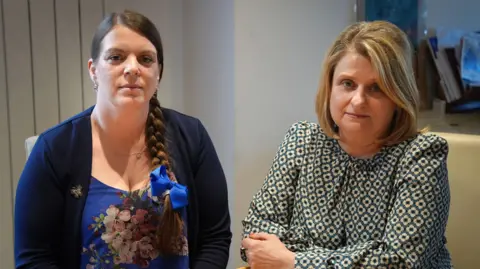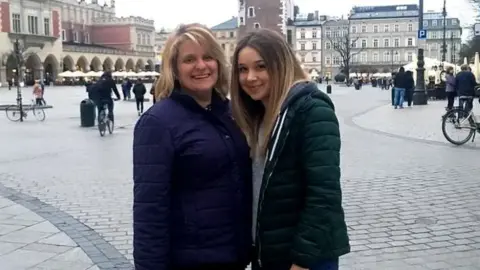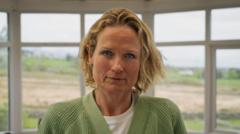
 BBC
BBC
People who have committed murder, manslaughter or stalking offences should be forced to live in restricted areas after being released from prison on licence, campaigners have said.
Rhianon Bragg said she felt “trapped” after her stalker was released from prison subject to an exclusion zone, which meant he could not enter the surrounding four counties of her home.
The Ministry of Justice said exclusion zones prevented offenders from approaching their victims.
But Ms Bragg is part of a group of victims who say this approach should be “flipped on its head”, with “high risk” former prisoners only able to live, work and travel in specific areas of the UK for the rest of their lives.
Some experts have raised concerns that such an approach could amount to a breach of perpetrators’ human rights.

 Rhianon Bragg
Rhianon Bragg
Ms Bragg, from Gwynedd, was stalked and held at gunpoint for eight hours by her ex-partner Gareth Wyn Jones in 2019.
Jones was jailed for four-and-a half-years in 2020 and later released on licence in February 2024.
Being on licence means that a person is still serving a prison sentence but can live in the community under strict conditions.
As part of Jones’ licence conditions he was not allowed to enter the surrounding four counties of Ms Bragg’s home for a period of five years, but Ms Bragg said she began to feel “trapped”.
“We hadn’t got freedom anymore, not truly,” she said.
“It may sound like a large area, but the clock was ticking.
“Just simply travelling and worrying about stopping at a service station that he might be there,” she added.
“Being outside the safety zone did feel like a real a risk, and it shouldn’t be like that.”
Ms Bragg recently found out that Jones had died.
“The morning after I’d been told that news, I couldn’t work out what I was feeling, I couldn’t put a name on it, it felt different, it wasn’t familiar, and then it suddenly came to me – it was freedom,” she said.
“Victims have been through enough already, we should all be able to feel freedom.”


Emma King said she had to “fight” for a five-mile exclusion zone around her home from the man who killed her sister.
Julie Butcher was murdered in 2005 by her ex-husband Richard Butcher at their home in Chiseldon, Wiltshire.
Butcher was jailed for 13 years but Ms King said he moved back to the same area after being released.
“We are actually imprisoned ourselves now in a small area and will be forever looking over our shoulders,” said Ms King.
She said 50-mile (80km) exclusion zones should be the minimum imposed on perpetrators, and that they should be imposed at sentencing to avoid further trauma for the families of victims.
Ms King has joined forces with Carole Gould, whose 17–year–old daughter Ellie was stabbed to death at her home in Calne, Wiltshire, in 2019, by Thomas Griffiths after she ended their relationship.
After hearing about Ms King’s experiences, Ms Gould said she said she was “horrified”.
“Naively I just thought Griffiths won’t be allowed back to the south west of England [after being released] but hearing what Emma has to say, that means Griffiths could move back and live with his parents who have chosen not to move out of the area,” Ms Gould said.
“They don’t take into account the anxiety we’re living with right now, let alone the grief, for what we should do for our long term plans.
“Should we move away or sit it out and see what happens?”

 Family Photo
Family Photo
Diana Parkes, whose daughter Joanna Simpson was killed at her home in Berkshire in 2010, has also endorsed the calls for restricted zones.
Ms Parkes, who set up the Joanna Simpson Trust in her daughter’s name to support children affected by domestic abuse and homicide, said victims were “absolutely terrified” when perpetrators came out of prison.
“Every single victim I have spoken to endorses this feeling that the offender should be in a restricted zone and the victim should be able to carry on their life, because they’ve done nothing wrong,” said Ms Parkes.
“Why should they only be made to feel safe in an exclusion zone?
“I’m fighting like mad until my dying breath to make sure people understand. Particularly the law makers, if they had lost a family member like us, they would really truly think differently.”
‘Human rights breach’
Latest Ministry of Justice data showed 62,821 people were on licence or subject to post release supervision as of September 2024.
Craig Court, a solicitor at Harding Evans, in south Wales, who has represented both prisoners and victims of abuse, said introducing restricted zones in which offenders could live and work would pose a “real risk” of breaching the Human Rights Act 1998.
He said the act had played a significant role in shaping how licence conditions were applied to offenders.
“Victims’ campaigns have rightly highlighted the need for more restrictive conditions to ensure their safety and psychological wellbeing,” said Mr Court.
“While I agree that such restrictive measures are crucial, especially where there is a continuing risk of harm, the act requires that any restriction – such as preventing an offender from entering certain areas – must comply with Article 5 [right to liberty] and Article 8 [right to private and family life] of the European Convention of Human Rights.”
Mr Court said these provisions did not prohibit restrictive conditions but did require them to be proportionate, necessary, and grounded in a clear assessment of ongoing risk.
He said the aim was to protect the needs of victims whilst not undermining the fundamental rights of offenders.
“As the law currently stands, confining an offender to a particular area or restricting an offender from leaving a defined area runs the real risk of breaching both Articles 5 and or 8,” he added.
Ms Gould said she felt the emphasis should be “flipped on its head”.
“It’s all about the perpetrators’ human rights and not ours, and that’s so wrong,” she said.
“The radius should be put on them. So we know where they are and we have the freedom of the UK.”
A Ministry of Justice spokesperson said: “Victims must feel safe, which is why any offenders released on licence who break the rules face going back to prison.
“They have to follow strict conditions, such as curfews and exclusion zones that prevent them approaching their victims, as well as restrictions on phone and internet use.”
If you are affected by any of the issues in this article you can find details of organisations that can help via the BBC Action Line.







